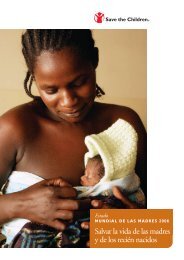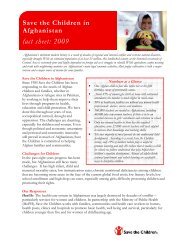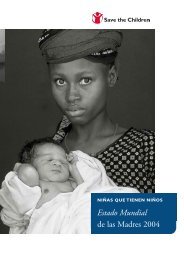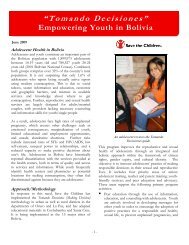Annual Report 2002 - Save the Children
Annual Report 2002 - Save the Children
Annual Report 2002 - Save the Children
You also want an ePaper? Increase the reach of your titles
YUMPU automatically turns print PDFs into web optimized ePapers that Google loves.
TOOLS TO TRANSFORM CHILDREN’S LIVES<br />
While considerable progress had been made over <strong>the</strong> past few decades, more than<br />
10 million children still die every year, many from preventable diseases. Four million of<br />
<strong>the</strong>se deaths are newborns.<br />
Additionally, nearly 600,000 women die – one mo<strong>the</strong>r every minute – from causes related<br />
to pregnancy or childbirth. Six hundred million children live on less than $1 a day. Over<br />
125 million children do not go to school, and nearly two-thirds of <strong>the</strong>m are girls. AIDS has<br />
orphaned about 14 million children, and three times that number are projected by 2010.<br />
Key to reversing <strong>the</strong>se dire statistics, and<br />
helping children to survive and thrive, are<br />
<strong>the</strong> world’s mo<strong>the</strong>rs. For 70 years, <strong>Save</strong> <strong>the</strong><br />
<strong>Children</strong> has successfully worked from <strong>the</strong><br />
principle that when mo<strong>the</strong>rs are given access<br />
to three essential tools – education, health<br />
care and economic opportunities – it creates<br />
real and lasting change in <strong>the</strong>ir lives, <strong>the</strong>ir<br />
children’s lives and for generations to come.<br />
HEALTHY MOTHERS = HEALTHY<br />
CHILDREN<br />
To lead healthy and active lives, children need proper<br />
nutrition and protection from disease not only during<br />
<strong>the</strong>ir childhood, but also before it even begins. <strong>Save</strong> <strong>the</strong><br />
<strong>Children</strong> has been an international leader in addressing<br />
<strong>the</strong> critical health needs of women and girls so that <strong>the</strong>ir<br />
survival and well-being can improve <strong>the</strong> lives of <strong>the</strong>ir<br />
children.<br />
Nepal<br />
Saving Newborn<br />
Lives starts with<br />
prenatal health<br />
care in countries<br />
with some of <strong>the</strong><br />
highest maternal<br />
mortality rates in<br />
<strong>the</strong> world.<br />
Saving Newborn Lives<br />
Based on decades of experience, building on existing<br />
programs, and with funding from <strong>the</strong> Bill & Melinda<br />
Gates Foundation, <strong>Save</strong> <strong>the</strong> <strong>Children</strong> has implemented<br />
its Saving Newborn Lives initiative in six countries that<br />
have among <strong>the</strong> highest maternal and infant mortality<br />
rates in <strong>the</strong> world. As part of <strong>the</strong> government of Pakistan’s<br />
maternal and neonatal tetanus program, for example,<br />
4.5 million women were vaccinated against potentially<br />
Myanmar<br />
Maternal health and nutrition programs allow women to deliver safely<br />
and raise children who thrive.<br />
fatal tetanus infection in <strong>2002</strong> thanks to Saving Newborn<br />
Lives’ nationwide campaign to educate women, families<br />
and community leaders about <strong>the</strong> importance of immunization.<br />
In India, <strong>Save</strong> <strong>the</strong> <strong>Children</strong> supported <strong>the</strong><br />
expansion of successful community-based newborn healthcare<br />
programs to 140 communities in Maharastra State.<br />
Saving Newborn Lives programs are also underway in<br />
Bangladesh, Nepal, Mali, Malawi and Bolivia, promoting<br />
<strong>the</strong> essentials of newborn health such as care for pregnant<br />
women, skilled birth attendants, clean delivery and proper<br />
care for newborns in <strong>the</strong> weeks following birth.<br />
< Afghanistan<br />
Making Mo<strong>the</strong>rhood Safe<br />
Every year, nearly 600,000 women — 99 percent of <strong>the</strong>m<br />
in developing countries — die from causes related to<br />
pregnancy and childbirth.<br />
SAVE THE CHILDREN 9




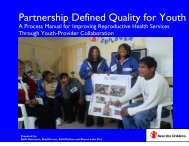

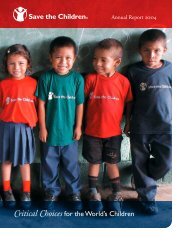
![View full document [PDF 3.39 MB] - PreventionWeb](https://img.yumpu.com/27308954/1/190x245/view-full-document-pdf-339-mb-preventionweb.jpg?quality=85)
